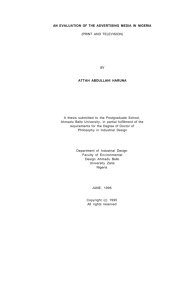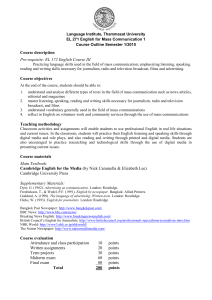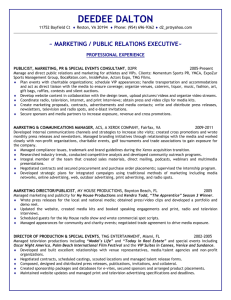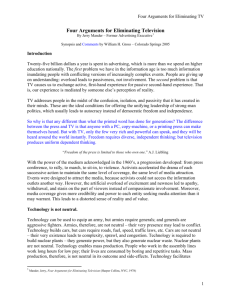MEDIA/SOCIETY
advertisement
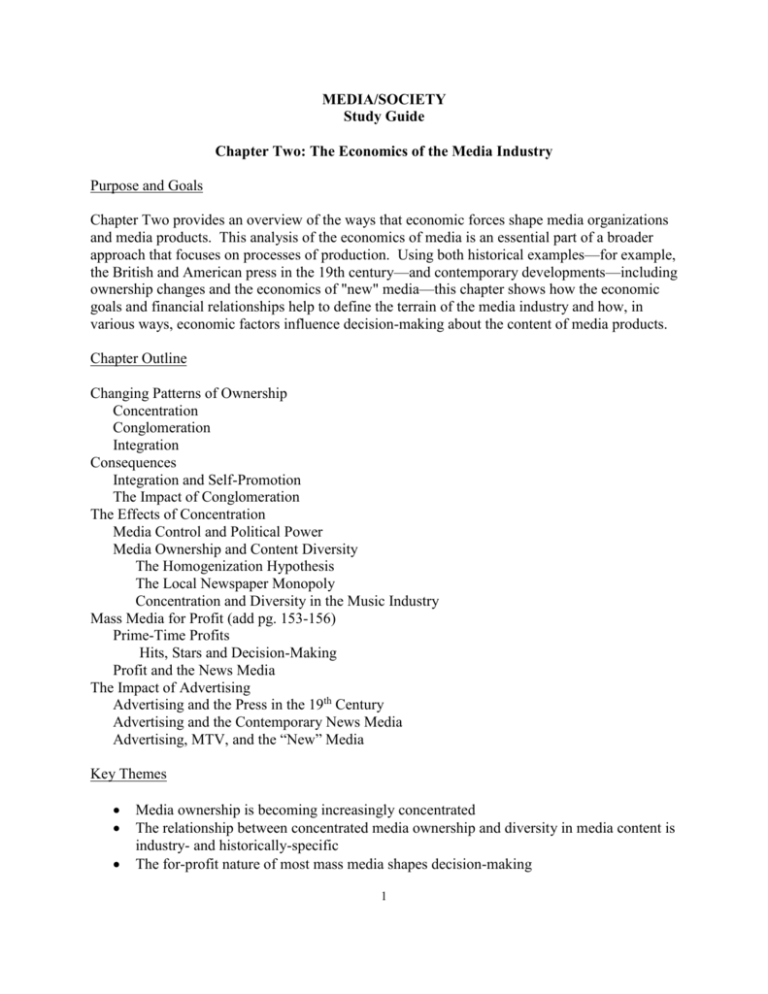
MEDIA/SOCIETY Study Guide Chapter Two: The Economics of the Media Industry Purpose and Goals Chapter Two provides an overview of the ways that economic forces shape media organizations and media products. This analysis of the economics of media is an essential part of a broader approach that focuses on processes of production. Using both historical examples—for example, the British and American press in the 19th century—and contemporary developments—including ownership changes and the economics of "new" media—this chapter shows how the economic goals and financial relationships help to define the terrain of the media industry and how, in various ways, economic factors influence decision-making about the content of media products. Chapter Outline Changing Patterns of Ownership Concentration Conglomeration Integration Consequences Integration and Self-Promotion The Impact of Conglomeration The Effects of Concentration Media Control and Political Power Media Ownership and Content Diversity The Homogenization Hypothesis The Local Newspaper Monopoly Concentration and Diversity in the Music Industry Mass Media for Profit (add pg. 153-156) Prime-Time Profits Hits, Stars and Decision-Making Profit and the News Media The Impact of Advertising Advertising and the Press in the 19th Century Advertising and the Contemporary News Media Advertising, MTV, and the “New” Media Key Themes Media ownership is becoming increasingly concentrated The relationship between concentrated media ownership and diversity in media content is industry- and historically-specific The for-profit nature of most mass media shapes decision-making 1 Media work is fraught with uncertainty, particularly about the route to "success;" media professionals seek formulas that will enhance the likelihood of success and/or decrease the perceived risk. Advertising has an impact on the nature of news Advertising can be a significant influence on new media developments Key Concepts and Terms “Big 3” Networks: the original television networks—ABC, CBS, and NBC Captive audiences: for example, people in office waiting rooms or children in classrooms, who can be targeted for programs containing commercials Closed system: a music industry system wherein major record companies used a limited number of channels to produce and distribute music Concentration: the process whereby media companies are owned by fewer and fewer parent companies Conglomeration: the process by which media companies have become part of much larger corporations, which own a collection of other companies that may operate in highly diverse business areas Cross-promotion: the ability of media conglomerates to promote products across different divisions through horizontal integration Fourth Estate: refers to the press, both in its explicit capacity of advocacy and in its implicit ability to frame political issues Hit system: the underlying operating principle for media companies whereby they rely on small number of big hits to remain economically viable Homogenization Hypothesis: the contention that ownership concentration and horizontal integration, which decreases competition, will lead to a homogenous media products Horizontal diversity: a measure of diversity in news content, referring to the differences in content between two newspapers Horizontal integration: the process by which one company buys different kinds of media, concentrating ownership across differing types of media Logic of safety: an attempt by network programmers to minimize the risk of losing money on TV programs that are ratings losers Mergers: in corporate business, fusion of two or more corporations by the transfer of all property to a single corporation Monopoly: market condition in which there is only one seller of a certain commodity; by virtue of the long-run control over supply, such a seller is able to exert nearly total control over prices Narrowcasting: targeting media products designed for smaller niche markets or audience segments Network programmers: television network executives who make decisions about which programs will air 2 Objectivity: is a significant principle of journalistic professionalism, and can refer to fairness, disinterestedness, factuality, and nonpartisanship, but most often encompasses all of these qualities Oligopoly: an intermediate market structure between the extremes of perfect competition and monopoly Open system: the major record companies control manufacturing, distribution and publicity, but draw on semi-autonomous independent producers to make the music Orwellian: describes the situation, idea, or societal condition that George Orwell identified as being unfavorable to the welfare of a free-society Product placement: the placement of real commercial products and services in various media, where the presence of a particular brand is the result of an economic exchange; appears in plays, film, television series, music videos, video games and books Production Perspective Record firms: major record companies Record labels: the numerous, smaller, independent labels controlled by a larger record firm Search engines: online services that allow users to scan the contents of the Internet to find Web sites or specific information of interest to them, for instance Google or Yahoo Spin-offs: a new TV series which contains either characters or theme elements from an old series Star principle: the idea that stars can attract audiences and thus secure hits for producers Synergy: the dynamic where components of a company work together to produce benefits that would be impossible for a single, separately operated unit of the company Vertical diversity: a measure of diversity in news content, referring to the range of actors mentioned and degree of disagreement in articles in a single newspaper Vertical integration: the process by which one owner acquires all aspects of the production and distribution of a single type of media Wire services: organizations established to supply news for a charge to other organizations in the news trade. Essay or Discussion Questions What is the difference between horizontal and vertical integration? Use examples from two industries to explain both the different ownership structures, their benefits to media companies, and the potential consequences. What is the political impact, if any, of concentrated corporate ownership of news and other forms of media? What is the relationship between media ownership and diversity in media content? Compare and contrast this relationship in the news and popular music industries. 3 Why was there expanded musical diversity in the 1980s, despite highly concentrated ownership? What does this suggest about the relationship between ownership concentration and media diversity? What are the consequences of the network television "logic of safety" for the kinds of programs that appear on prime time television? Why do television executives pursue this "logic of safety?" What are the economic forces that have helped to make the television "newsmagazine" such a prominent part of the network prime-time schedule? Why are “stars” so sought after by media producers? What is it that these starts bring to media production? How did the rise of a commercial press, supported financially by advertising, influence the development of the British and American press in the nineteenth century? What is the relationship between news and advertising today? What role are advertisements likely to play in the emerging world of cyberspace? What role do advertisements play on the Internet today? 4





